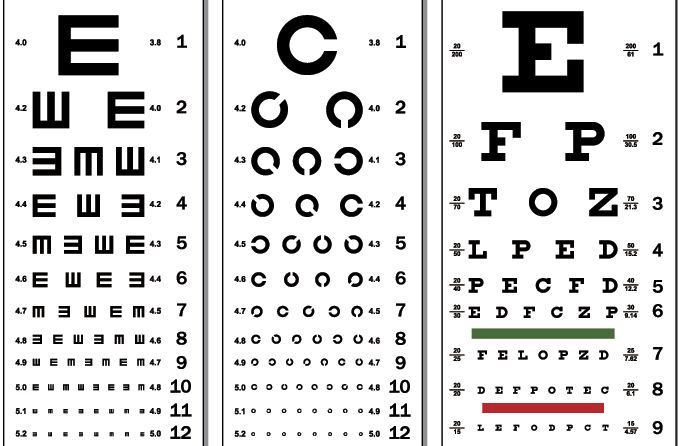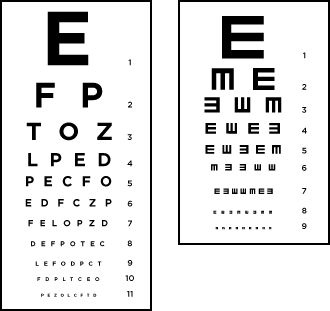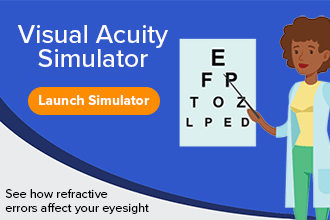Visual acuity and visual acuity tests
- What is visual acuity?
- How is visual acuity measured?
- What are common distance visual acuity tests?
- What are common near visual acuity tests?
- How is visual acuity measured in infants?
- Why are visual acuity tests useful?
- Is there more to vision than visual acuity?
- Can kids have perfect visual acuity and still have vision problems?
- How can I get my visual acuity tested?

What is visual acuity?
Visual acuity is the ability to see distinct figures and fine detail with clarity. With good visual acuity, the outline of an object is sharp and easily detectable.
Visual acuity tests measure how well a person sees fine details at distance and near.
How is visual acuity measured?
Doctors test visual acuity by using eye charts. They measure how well a person can see fine detail at a specific distance. High contrast figures (for example, black letters on a white chart) are used in visual acuity tests.
Visual acuity tests provide information about how clearly a person is seeing. For example, the ability to see street signs, the front of a classroom or words in a book depends on good visual acuity.
What are common distance visual acuity tests?
There are many types of visual acuity tests. These tests are designed for different ages and levels. For example, a small child who cannot speak yet will need a different visual acuity test than a college student.
Distance visual acuity tests are usually done at 20 feet or 6 meters. “Perfect vision” is considered to be 20/20 vision.

How a Snellen chart and a "tumbling E" chart might look at your eye doctor's office.
The most commonly used tests to measure distance visual acuity are:
Snellen Chart – A chart with rows of capital letters, with each row decreasing in size. Usually used for older children and adults
Random E Chart – A chart with rows of a “tumbling” E facing different directions. Each row decreases in size, similar to the Snellen chart. Usually used for young children who can point in the direction that the E is facing.
What are common near visual acuity tests?
Near vision tests are usually done at 16 inches or 40 cm. The most common near visual acuity tests are:
Reduced Snellen – A miniature Snellen test. “Perfect” vision is the ability to read the 20/20 line.
Jaeger – Paragraphs of text increasing in size. “Perfect” vision is the ability to read the J-1 line.
How is visual acuity measured in infants?
Infant visual acuity is measured by a technique called “preferential looking.” The most common type of preferential looking test is with the use of Teller Acuity Cards.
Preferential looking tests do not need a person to respond. They are performed using the following technique:
The tester holds up a blank, gray card with no pattern and a card with a pattern that is “more interesting” to look at.
The person being tested turns their head to look at the “more interesting” card with a pattern.
As the test progresses, sharper visual acuity is needed to see the markings on the patterned card.
When the patterns on the card become too difficult to see, both cards look alike. There is no head turn due to “preferential looking.”
Why are visual acuity tests useful?
Doctors use visual acuity tests to determine the correct prescription for glasses or contact lenses.
Visual acuity tests can also determine whether:
An infant or child has proper visual development.
A person has the required visual acuity to get a drivers license.
A person qualifies for special services due to decreased visual acuity.
A disease has progressed and caused changes in vision.
A medication is effective in stabilizing vision or preventing vision loss.
Is there more to vision than visual acuity?
Yes. The brain gets many different signals that contribute to vision. A visual acuity test measures one aspect of vision: how clearly a person sees a high contrast object.
Driving in rainy weather, keeping your eye on a soccer ball or chopping vegetables all require more than just good visual acuity. Many components of vision work together to give “good vision.”
Some components that contribute to good vision include:
Contrast sensitivity – The ability to discern a figure from its background.
Color – The ability to perceive different colors (see color blindness).
Depth perception – The ability to judge the distance of an object, 3D vision.
Glare sensitivity – A decrease in visual acuity due to bright lighting.
Visual fields – Your field of vision when your eyes are focused ahead.
Binocular vision – The ability to clearly focus on a single target with both eyes.
Visual tracking – The ability to track moving objects.
Can kids have perfect visual acuity and still have vision problems?
Yes. Good visual acuity does not guarantee that a child has all the visual skills needed to perform well academically and outside the classroom.
Some kids who have “perfect” visual acuity may still need visual therapy to address other visual problems.
READ MORE: Vision therapy for kids
Vision issues that may require visual therapy are:
Amblyopia – “Lazy eye” due to improper vision development in childhood.
Strabismus – “Crossed eyes” due to eyes not lining up and working together.
Binocular vision disorders – Double vision due to the eyes not being able to focus together and see a single image.
Tracking difficulty – A decreased ability to visually track moving objects.
Accommodative disorders – A decreased ability to focus on near objects.
How can I get my visual acuity tested?
A comprehensive eye exam, including visual acuity testing, can be performed at an eye doctor’s office.
Keeping your eyes healthy by eating nutrient rich foods, exercising and spending time outdoors will help to maintain good visual acuity throughout life.
How to measure distance visual acuity. Community Eye Health. June 2014.
‘Preferential looking’ for monocular and binocular acuity testing of infants. British Journal of Ophthalmology. April 1982.
Teller acuity cards reference and instruction manual. Stereo Optical Co. 2005.
Distance and near visual acuity, contrast sensitivity, and visual fields of 10-year-old children. JAMA Ophthalmology. January 1999.
Page published on Tuesday, July 20, 2021







